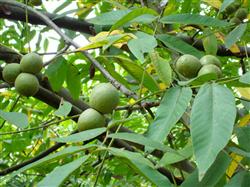What are the fruit diseases of walnut trees in the late stage?

What are the diseases of walnut fruit in the later stage? Please introduce the following diseases in the later fruit of walnut tree: first, the symptoms of walnut anthracnose disease: after the fruit is damaged, there are brown to black-brown round or near-round spots on the pericarp, sunken in the center and small black spots, sometimes in the shape of concentric rings. When the air humidity is high, there are pink protuberances on the disease spot. The disease spot can be connected into a piece for a long time, making the fruit black, rotten or early. The disease spot of the leaf is irregular, mostly in strip shape. The diseased leaves are withered and yellow, and the seriously diseased leaves all turn yellow. The disease conditions: the disease usually occurs from June to August, and is serious in orchards with heavy rainfall, weak trees, dense branches and leaves and extensive management, and the spores invade from the wound or natural orifice. Control methods: ⑴ removed diseased branches, diseased fruits and diseased leaves and concentrated burning. Strengthen tree management and improve ventilation and light transmission conditions. When the rainy season of ⑵ comes, spray Bordeaux solution of 1-100 (cupric sulfate: lime: water) every 10-15 days to prevent diseases. When a disease occurs in ⑶, 40% carbendazim wettable powder can be sprayed 1000 times, 75% chlorothalonil 600 times, 70% topiramate 800 times, once every 15 days, 2-3 times. Second, symptoms of walnut bacterial black spot disease: after the fruit was damaged, small black-brown spots began to appear on the fruit surface, and then expanded into round or irregular black spots and sunken, no obvious edge, surrounded by water stains, and the fruit rotted from the outside to the inside. After the leaves are susceptible, small black spots first appear along the leaf veins, and then expand into near-round or polygonal black spots, resulting in severe disease spots, resulting in perforation. Onset period: it generally occurs from May to August and can be infected repeatedly. Bacteria invade from lenticels or wound holes, and the disease is serious in the rainy season of high temperature and humidity. Control methods: ⑴ selected disease-resistant varieties, such as Gift No. 2, Xiangling, Fenghui, Shanhe No. 1 and so on. ⑵ strengthened cultivation management, combined with pruning, timely removal of diseased fruits, diseased branches and diseased leaves, enhanced ventilation and light transmission, and improved tree structure. ⑶ sprayed 3-5 Baumetulite sulfur mixture once before germination to eliminate overwintering pathogens. Spray 1-3 times 1-3 times of Bordeaux solution (1-3 times) of Bordeaux solution, or 500-800 times of methyl topiramate or acetaminophen wettable powder (female pre-anthesis, post-anthesis and young fruit stage); 50 mg / L streptomycin plus 2% copper sulfate, once every 15 days, with good results. Click to get more hickory planting techniques click to get more fruit planting techniques
- Prev

What problems should be paid attention to in the cultivation of walnut trees?
What problems should be paid attention to in the cultivation of walnut trees? In the cultivation of walnut trees, we should pay attention to the following problems: walnuts are widely distributed in China, ranging from southern Liaoning in the north to northern Fujian in the south, Shandong and Zhejiang in the east, Qinghai, * and Sichuan in the west. The elevation can be normal in the case of 500m-2500m.
- Next

How to harvest and deal with walnuts?
How to harvest and deal with walnuts? Please guide the harvest and treatment of walnut can refer to the following methods: in order to ensure the yield and quality of walnut, it should be harvested when the nut is fully ripe, but it should not be too late, otherwise the green skin will be cracked and hung on the tree for too long. It will increase the chance of mold infection, resulting in.
Related
- Moge, come on! The staff of the peasant association in the producing area of cantaloupe were frightened when the crowd gathered.
- Causes and Solutions of low Fruit setting rate of Apple
- Symptoms and control measures of passion fruit virus disease
- Fruit growing lesson: how do apple orchards keep high yields?
- Can you build orchards in the mountains? What are the pros and cons?
- How to manage the coloring period of Crisson grape?
- This paper introduces the processing technology of two kinds of fig products.
- How much is a month for retired teachers in rural areas by 2020?
- How can strawberry planting increase sugar content? We should pay attention to management in many aspects.
- What are the cultivation techniques on how to improve the yield of golden fruit?

